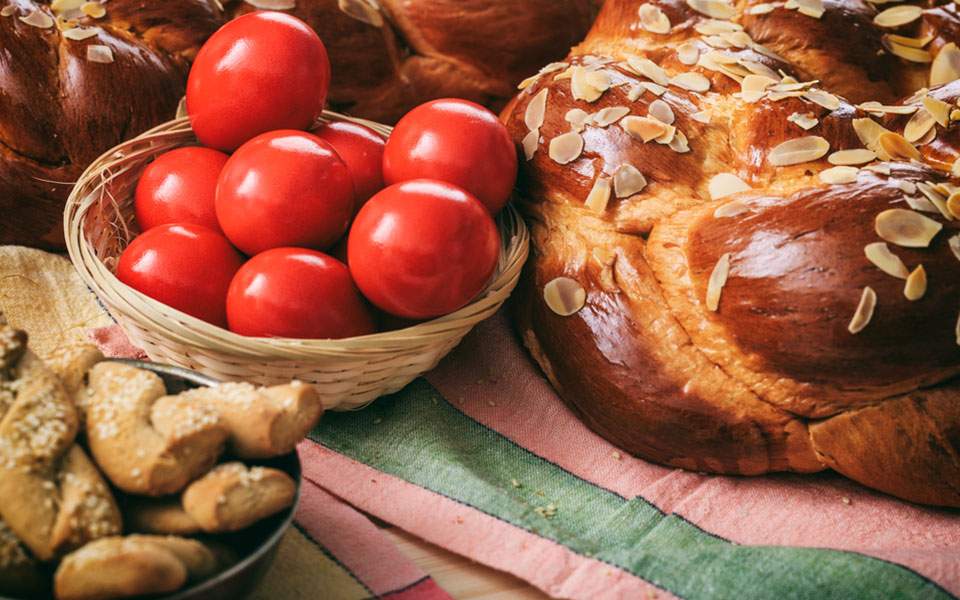
Easter in Zakynthos

A great religious celebration which is important for its ceremonial in Zakynthos (Zante), is Easter.
Easter in Zakynthos is celebrated with great formality and many preparations. For the entire Holy week the feelings and the deep emotion for the Holy Passion is universal. The crucifixion, which according to the scriptures on the noon of Good Friday, dresses the whole Island in grief. The priests in simple black vestments starting from the church of Saint Nicholas of Molos, carry the Crucifix around the streets of the city. Black cloths hang from the balconies and the bells are silent. The Litany of the Crucifix ends at Solomos square after having followed the same itinerary which is followed each year.
A noteworthy “Andeti” of the same day for the Zakynthians is to drink vinegar in remembrance of the vinegar which was offered to Jesus Christ on the cross.
In the morning of Easter Saturday the “Gloria” takes place which is the first resurrection of our Lord with a liturgy and joyfully tolling bells. On the balconies, red celebratory scarves are hung and a water pot is left to fall and break with the Zakynthians saying the following phrase, “To the shame of the Hebrews and the joy of the Christians”.
In the past the Hebrew shops of the city, which were then kept by the numerous Jewish community, used to find in the morning of Easter Saturday their signs changed or gathered one on top of the other in the square. This was the “Andeti” of the Zakynthians.
So there was for a short time confusion about what was sold at each shop and where its sign was.
The great resurrection of the Lord is celebrated with pomp on the evening of Easter Saturday at the Square of St Mark. On Easter Sunday lambs are roasted on the spit in the streets according to the custom which prevails all over Greece. In the afternoon of the same day the local “Panigyria” starts in villages with litanies, worship, dancing and feasting.
Easter for the Greek orthodox is celebrated more than Christmas. Maybe it has to do with the spring, maybe with the composition of the greek soul! With the whole week before Easter Sunday being of unique importance everywhere in Greece, every place has its own customs and traditions! So does Zakynthos… It would take hours to read all things happening during the Holy Week on the island. The four things, however, you should not miss if you happen to be in Zante for Easter, are the following:
1. Litany of the Crucifix on Holy Friday
Holy Friday is a day of grief. People fasten even more strictly on this day, while they dress formally and go to Zakynthos town to mourn the crucifixion of Jesus.
So, at noon a ceremony takes place that can’t be seen anywhere else in Greece- it’s typical for Zakynthos! Priests carry a big crucifix across the town accompanied by the philharmonic orchestra. People gather around 2.00 p.m. at the Solomos square dressed in grief to wait in reverence for the crucifix. The litany arrives and a priest enters the podium in the middle of the square and with a sorrowful music played by the philharmonic orchestra in the background and holds the crucifix high for all faithful to see, and share their grief…
2. Τhe “Epitaph” before sunrise
Holy Friday however isn’t over after that! In the evening, every village mourns the death of Jesus Christ carrying an “Epitaphios” (symbolic bier of Jesus Christ)- decorated with flowers by women and children- around the village, while the faithful follow the procession…
In Zakynthos Town however, something special happens: The “Epitaph” procession takes place after midnight! The exact time is calculated according to the time the sun rises and is usually around 3 a.m.! Some go for a drink at night and stay awake over night; others wake up and make their way to town some time after midnight. The town, however, is more crowded than at midday! And of course the philharmonic orchestra wouldn’t miss from there!
When the “Epitaphios” is returned to the church, a special mass starts. And by sunrise the “First Resurrection” is simulated, with loud noises, bellringings and the lights turning on and off. While outside, people form a circle and break their “stamnes” (clay pitchers) in the middle of the circle.
After that long night, the sunrise is always a little bit more beautiful to watch!
3. The Resurrection
After the sleepless night, some go sleep, but most continue the preparations for the evening and the following day. So at night, on Holy Saturday people dress elegantly and gather at the square of their village’s church, with their beautifully decorated candles, waiting for midnight. When the clock hits 12, fireworks are shot, while the priest hands out the Holy Fire, which is spread from candle to candle until everyone has a small Holy Fire burning. At the same time villagers enthusiastically say to each other, “Christos Anesti” (Jesus Christ is resurrected), while others answer “Alithos Anesti” (he truly is!) Then they gather at home to eat the traditional “magiritsa”.
4. Easter Sunday, the big feast!
Tradition has it that on Easter Sunday amidst the euphoria accompanying Christ’s resurrection, family and friends gather early in the morning and roast lamb on a spear, while enjoying traditional music, snacks and making competitions with each other on the resistance of the red-coloured eggs. At noon when the lamb is crusty and well-done, they gather around the table and have a big feast!